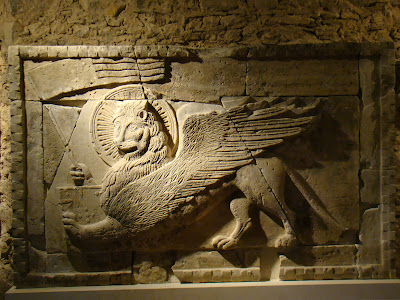In
a graduate class on Venetian history, a young man was
discussing the role of the "Dog of Venice." He was a Navy SEAL, and we
admired him too much to smile, or to embarrass him
with a correction. But I have cherished that Dog of Venice, and was utterly delighted when Pierre MacKay said, But that is what the Ottomans called the lion!
Correspondents have sent me references, which Pierre MacKay translated. Claudia Römer sent a passage from Evliya Çelebi SN VIII 309b about Candia in 1668:
Correspondents have sent me references, which Pierre MacKay translated. Claudia Römer sent a passage from Evliya Çelebi SN VIII 309b about Candia in 1668:
First of all, Kanye means dog-house in the Italian Frankish language, because the Venetian Franks who worship a two winged dog named San Marco, dedicated it to San Marco the dog under the name Kanye.
Then from Gülçin
Tunalı, from Mahmud Efendi in Tarih-i
Medinet'ül- Hukema, 48b, ca. 1700:
They treated this dog with great respect and reverence. When the dog died they buried it and built a shrine and temple over it. Over the door of the shrine they depicted the dog and revered it. And not satisfied with this level of honor, everyone to the best of his ability made an image of the dog out of silver and gold and placed it on the house as a blessing. Rich and poor, small and great, each to the extent of his means, expended them for the making of a gold, silver, copper or brass image of the dog. And still, today, Venetian infidels love no animal as much as they do the dog.
Robert Dankoff comments that Evliya (SN.IX257b15) called the Venetian ducat the kelbi
ḳuruş = the dog ducat.
So here are some dogs of Venice:
End of ceiling beam, Ag. Paraskevi, Halkis, ca. 1270.
Halkis
Halkis
Methoni
Heraklion
Rethymno
Nauplion
Methoni
Methoni
Methoni
Nauplion
Nauplion
ca. 1470
Nauplion, ca. 1700 & 2009
The finest lion of all, Halkis.















Not to forget that the Ottoman Turkish word "Kelb" comes form the arab word "kalb" meaning dog, and in Islam, dogs are traditionally seen as unclean animals. "Dog" was a common pejorative term for infidels that Ottomans and Arabs alike used to call the Byzantines and Catholic Christians.
ReplyDeleteLions ("aslans") on the other hand were, of course, highly important symbols of power in islamic culture. One finds them in art, often resembling a dog or cat, or as epithets (alsan or arslan).
Given the number of close encounters that the Ottomans had with the Venetians across the centuries, living as they did side by side, fighting and trading with each other, it would seem unlikely that Evliya ignored the fact that the Venetian symbol was, in fact, a highly stylized lion and not a dog.
So Evliya's description of the Venetians worshipping an unclean animal could be a form of delierate misinterpretation, either to amuse his readers or for the purpose of propaganda.
I hasten to answer that of course it is. One of the great failings in the use of the Seyahatname over the past two centuries is the habit of treating him as a dour. serious writer, offering, at best, a mechanical source of economic data, etc, Remember that Evliya regarded himself as a Nedim, and that he had an unmistakable sense of humour, In many of the cases where Evliya has been accused of illiterate unhistorical ignorance, he is simply trying to be funny. It is one of his charms that he is quite capable of making himself the butt of his own jokes.
DeletePierre MacKay
www.angiolello.net
P.S. The lion on the Cruxifix at the Pantocrator monastery on Mt. Athos is probably not a particularly Venetian lion of St. Marco but rather a more general St. Mark as lion, part of the Tetramorph. You can see the Eagle, the Ox and the Angel in the other corners of the cruxifix. So it shouldn't be so unexpected to find a lion depicted there.
ReplyDeleteI quite enjoyed this post having just come out from under a deep cloud of sadness after the death of our sweet dog. I smiled at your student's Dog of Venice and remember my student who did a presentation of the Pre-Columbian temple at "Chicken-It's-A".
ReplyDeleteThank you, Emanda -- I still get sad about the dog that died in 1963.
ReplyDelete